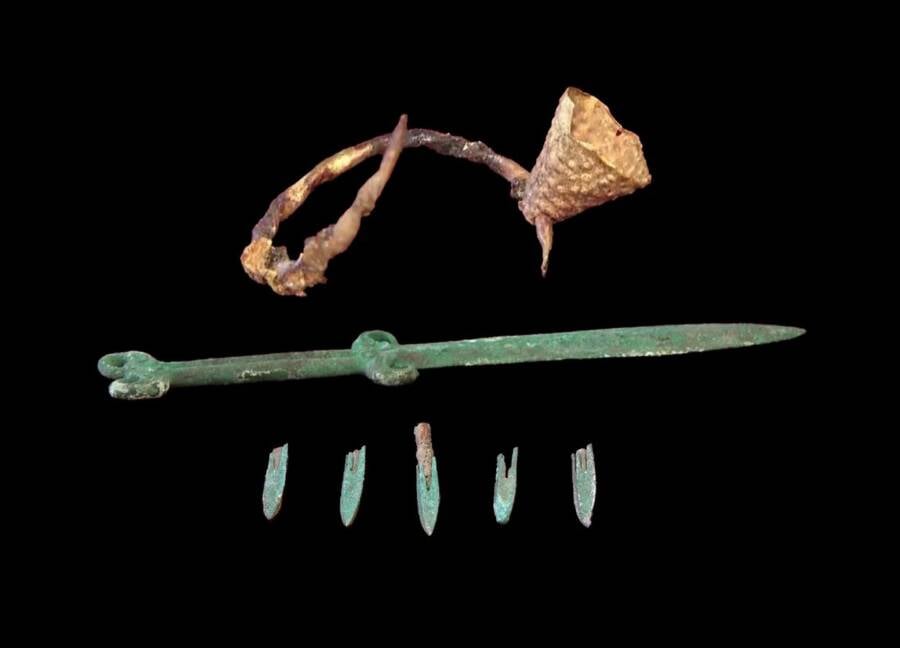Archaeologists In Kazakhstan Just Discovered The Remains Of A Saka Warrior Holding A Bronze Sword Inside A 2,500-Year-Old Tomb
Karaganda Regional MuseumThe sword and grave goods found in the Saka warriors tomb.During excavations in the Karaganda region of Kazakhstan last summer, archaeologists uncovered the rare, untouched, 2,500-year-old grave of a Saka warrior. Not only was the warrior himself completely intact, but he was also found holding a small, 12-inch bronze sword. This thrilling find offers a tantalizing glimpse at the world of the Saka civilization, a nomadic people who existed from the ninth century B.C.E. to the fifth century C.E. across the Eurasian Steppe. The 2,500-Year-Old Tomb Of A Saka Warrior With A Bronze SwordKaraganda Regional MuseumThe bronze akinak that archaeologists found in the warriors hand. According to reporting from Kazinform International News Agency, the discovery of the warrior and his sword was made during excavations led by the Karaganda Regional History Museum. Archaeologists uncovered his tomb at the Karabie burial site in the Aktogay district during excavations in summer 2025. Within a burial mound, they found his tomb, which had gone practically untouched for the past 2,500 years. Inside, archaeologists found the warrior, whose body was intact, as well as the bronze akinak, or short sword, which he held in one of his hands. After removing the covering slabs [of the tomb], we saw a skeleton in correct anatomical order. In his right hand was an akinak. We havent had such findings in many years, Dauren Zhussupov, Head of the Archaeology Department at the Karaganda Regional History Museum, stated. We expected to find typical remains from the Saka period, but the fact that the burial mound has been preserved in its original form is extremely rare.The double-edged sword is roughly 12 inches long and is decorated with the birds of prey that hunt in the Eurasian Steppe. It was found alongside five metal arrowheads and a gold earring, possible nods to the warriors status. This type of akinak, with such design, has not yet been found elsewhere in Kazakhstan, archaeologist Arman Beissenov remarked. It reflects the high level of metallurgy and artistic taste of the Saka age.Karaganda Regional MuseumA gold earring, which was found in the Saka warriors tomb alongside the sword and five metal arrowheads. Archaeologists believe that the tomb dates back to between the sixth and seventh centuries B.C.E., a time when the nomadic Saka people roamed the Eurasian Steppe. A Brief History Of The Nomadic Saka PeopleThe Saka people were a nomadic eastern Iranian civilization that existed between the ninth century B.C.E. and the fifth century C.E. Made up of disparate tribes, some Saka people farmed or built permanent structures, but most traveled across Asia and even into south Siberia. Public DomainThe area where the Saka people roamed thousands of years ago.According to the Astana Times, they were warriors renowned for their horseback riding skills. Not only were their horses reputed for their high endurance, but the Saka people were also known for perfecting the art of making horse harnesses.Their leaders were often buried in large burial mounds, warriors in small ones, and commoners in simple graves. Indeed, its not the first time that archaeologists have come across Saka burials. In recent years, they also uncovered an Iron Age burial mound that contained the remains of two Saka teenagers and a number of grave goods, including gold necklaces and other jewelry. Intriguingly, one teenager was also holding a bronze sword in his hand, just like the warrior found in the Karaganda region. As such, the discovery of the warrior with the sword is yet another glimpse at the Saka civilization, which was slowly eroded by various conquerors over the centuries. The warrior, his sword, and the other grave goods found in his 2,500-year-old tomb will next undergo metallographic, radiocarbon, and anthropological analyses. Hopefully, these provide even more insights about the nomadic Saka people of the Eurasian Steppe. After reading about the Saka warrior who was found buried with a bronze sword and other grave goods in Kazakhstan, look through these photos of armor worn by warriors throughout history. Or, discover the strange theory of the Tartarian Empire, a powerful lost civilization that allegedly once existed in Kazakhstan, as well as parts of Mongolia, China, and Russia.The post Archaeologists In Kazakhstan Just Discovered The Remains Of A Saka Warrior Holding A Bronze Sword Inside A 2,500-Year-Old Tomb appeared first on All That's Interesting.


